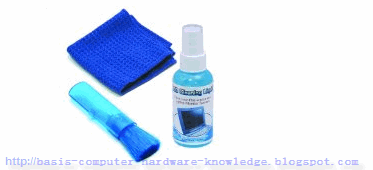How to clean up LCD LED Monitor screen
Do you know the how to clean the monitor screen of your computer or laptop? How to clean LCD screens or the latest LED screen and not harm the screen?This post bought to you by basic computer hardware knowledge blog..
Like most of us ,we might clean the laptop screen or LCD TV,plasma TV with water which is wrong, An LCD (liquid crystal display) or LED( light-emitting diodeconsists)is a soft film that is very sensitive and might damage from scratches, smudging, and clouding caused by the use of improper cleaning agents and harsh cloths.
DON'T! use ordinary tap water often include chemicals like chloride that will leave a residue on your screen.In additional coarse, paper towels or cloths may even scratch and damage your very sensitive LCD display, causing clouding and can even lead to dead pixels.
YOU need to be to be very careful when cleaning up you LED monitor or LCD screen ,wrong kind of cloth will most likely scratch the display screen,learn to use the proper way to clean an LED and LCD screen.
When you at computer store,you've probably have seem some of those LCD,LED cleaning solutions ,yes there are made for cleaning your monitor screen ,the best part is there will always included a soft cloth that is specialty used of cleaning the surface of monitor screen,and a bottol of cleaning liquid,the good news is you can DIY the cleaning liquid yourself , you only need 2 ingredients which is Isopropyl alcohol and Distilled Water.
DO NOT use rubbing alcohol, as it has lubricants in it that will smudge the screen and make it cloudy and just a gawd awful mess!For the same reasons why you DO NOT use 'rubbing alcohol' to clean cassette tape heads or CD/DVD lenses ...
The lubricant in rubbing alcohol will do them more harm than good!You will be able to find 85% (or better) pure isopropyl alcohol -- without lubricants added -- at most drugstore or pharmacies.Note that the 50% isopropyl alcohol cleaning solution seems to be endorsed by IBM also: http://www-307.ibm.com/pc/support/site.wss/document.do?lndocid=MIGR-4A2P54
The step is easy and simple,just mix the both liquid which is Isopropyl alcohol and distilled water in equal parts (50/50) ,you can moxing up them inside an empty Windex-like bottle.Warning! Do not use tap water!
Tap water is diffrence to Distilled Water it will leave white smears on your screen after cleaning it up because of the dissolved minerals inside the water.
Remember always use a good, soft piece of microfiber cloth to clean your LCD ,LED monitor screen. Don't use paper ,tissues!! i know there were many people used paper ,tissues to cleaning up the screen,using those on your LCD,LED screen would be just like scrubbing sandpaper on it and may scratch it permanently.
Another point to remember is always turn off your LCD,LED screen while cleaning.,Dampen your piece of soft cloth with your cleaning mixture and then wipe the display gently from top to bottom. Never spray liquid directly onto the monitor screen!!!
Do it right ,use the right material ,after cleaning the screen, wait a few minutes to let your screen dry, and then turn it back on,your LCD,LED screen should now be sparkling clean.
others suggestion on materiel clean uo LCD LED Monitor screen:
-Distilled Water+Vinegar
Vinegar mixed with Distilled water at a concentration of no more than 10% vinegar. That's 6 1/2 tablespoons of vinegar per quart of water, 1 1/2 tablespoons per cup, or 100 ml per liter.
-Isopropyl Alcohol
-Petroleum Benzene
If you not sure how to mix those materail,you might also use "Glass Plus: Glass & Surface Cleaner" spray.which consists of 'Biodegradable cleaning agents', and it's essentially isopropyl alcohol.
Any cleaning products you use,remember,you should never spray anything directly on the screen. Liquid and electronics don't get along well and it's possible for the sprayed solution to get inside the monitor.
If you thinking to use a product that was specifically made to clean LCD screens,you can buy one online at Amazon ,it really cheap and effective...
Klear Screen iKlear iPod,LCD Cleaning Kit
Endust for Electronics LCD & Plasma Pop Up Wipes 70 CT 11506